Darlington, Durham
Up to 1834
A parliamentary report in 1777 recorded a local workhouse in operation at Darlington with accommodation for up to 100 inmates.
The Old Workhouse on the banks of the River Skerne in Lead Yard, Darlington, was previously a Bishops's Palace, originally dating from around 1164. In 1806, the building was purchased from the Bishop of Durham for use as a township workhouse.
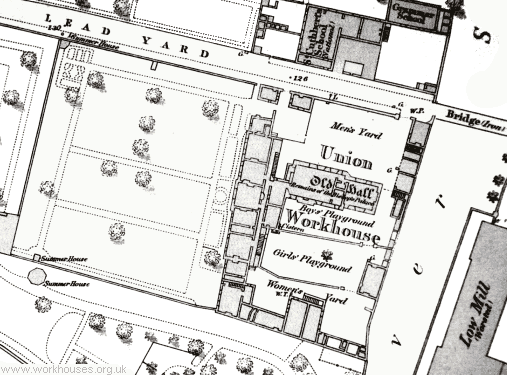
Darlington Lead Yard workhouse site, 1856.
Men were accommodated at the north of the site and women at the south, with children's playgrounds at the centre.
After 1834
Darlington Poor Law Union formally came into existence on 20th February 1837. Its operation was overseen by an elected Board of Guardians, 50 in number, representing its 41 constituent parishes as listed below (figures in brackets indicate numbers of Guardians if more than one):
Parish of Darlington:
Darlington (9), Archdeacon Newton, Blackwell, Cockerton.
Parish of Grinford:
Denton, Haughton-le-Side, Pierce Bridge, Summerhouse
Parish of Haughton-le-Skerne:
Haughton-le-Skerne, Barmpton, Great Burdon, Coatham Mundeville, Morton Palms, Sadberge, Whissoe.
Parish of Heighington:
Heighington, Coatsamoor, Killerby, Redworth, School Aycliffe, Walworth, Hurworth (2), Neasham, Middleton St George.
Parish of Sockburn:
Sockburn, Girsby, Over Dinsdale, Barton, Newton Morrel, Cleasby.
Parish of Croft:
Croft, Dalton, Stapleton.
Parish of Gilling:
Eryholme.
Parish of Manfield:
Manfield, Cliffe.
The population falling within the Union at the 1831 census had been 18,883 — with parishes ranging in size from Coatsamoor (population 13) to Darlington itself (8,574). The average annual poor-rate expenditure for the period 1833-35 had been £6,882 or 7s.3d. per head of the population.
The Old Workhouse was taken over by the Darlington Union and continued in use until a replacement was opened in 1870. At the end of 1867, The Darlington held a competition for plans for a new workhouse, with prizes of £40, £30 and £20 for the best three submissions. From the 116 entrants, the designs of Charles J Adams of Stockton-on-Tees were chosen. The new building, erected at a site on the south of Yarm Road, was for 250 inmates and 50 vagrants. The final cost of construction was over £12,000.
The new workhouse had a T-shaped main building. The north end, fronting onto the road, was 157 feet 10 inches long, with a tall central entrance archway and tower above. Women's accommodation was located to the west of the building and men's to the east. On the ground floor were day rooms for the able and infirm, and dormitories for the infirm nearest to the entrance. Dormitories for the able-bodied were on the floor above. The Master's quarters were at the far eastern end. The long stem of the T contained the dining hall and kitchen. A view of the new building is shown in a drawing from 1868.
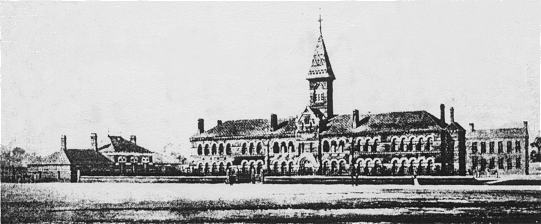
Darlington new workhouse from the north, 1868
To the east of the main building was the long single-storey board-room building. As well as the board room, it contained the porter's lodge, receiving ward, vagrants' wards, clothes-rooms, workshops, stone-breaking shed, coroner's and dissecting room, and hearse house.
To the south of the workhouse was the two-storey U-shaped infirmary. A separate fever ward lay to its east. The site layout is shown on the 1914 map below.
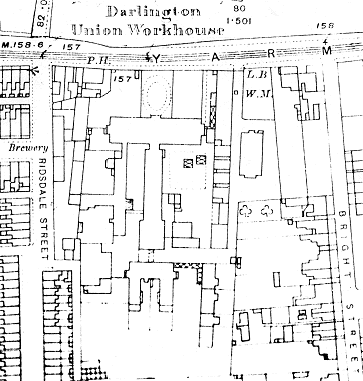
Darlington workhouse site, 1914.
In 1894, the British Medical Journal set up a "commission" to investigate conditions in provincial workhouses and their infirmaries. Following a visit to Darlington, the commission's report found that "the structure of the infirmary leaves little to be desired." Their recommendations included: an increase in the daytime nursing staff and the appointment of a night nurse; the separation of the idiots and imbeciles from among the sick and infirm; separate accommodation for venereal cases; a paid attendant for the infants, and the provision of sleeping cots for them at night; and improved ventilation of the wards. Further details are available in the full report.
In 1896, the Guardians moved their offices to a separate building on the corner of East Street and Poplar Road. Following this, the board-room block was probably converted into additional able-bodied accommodation. This may have been done as part of various additions works carried out in 1910-13 which included the erection of a T-shaped extension at the women's side on the west.
The institution later went through a number of name changes: in the 1920, it was know as Feetham Infirmary or New Feetham's Institute, then after 1930 as Darlington Public Assistance Committee Municipal Institution or the Municipal Hospital. It later provided care for the elderly and was known as East Haven Hospital. Virtually all the original workhouse buildings have now been demolished. The former Guardians' Offices on East Street and Poplar Road were in use as the Darlington Register Office until 1973.
Liz Cole has kindly contributed the following two pictures of her great-grandfather William Cox, taken in the workhouse in the late 1920s.
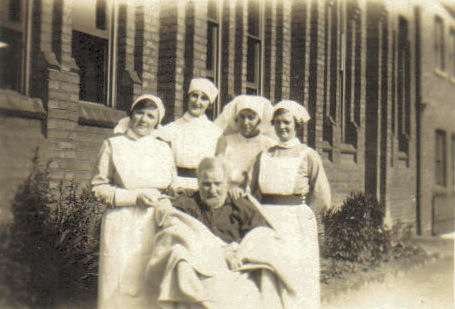
William Cox, inmate of Darlington workhouse, late 1920s.
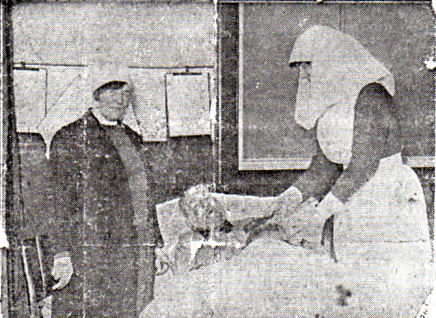
William Cox, aged 98, pulling a Christmas cracker with one of the workhouse nurses, 1928.
Cottage Homes
The Darlington Union operated several homes to house its pauper children. A girls' home was opened in about 1899 on Kendrew Street, Darlington. It susbsequently moved to Queen Street (now Commercial Street) then in 1911 to premises at 107 Eastbourne Road. A pair of cottage homes for boys was erected at 70 Falmer Road, known as the Park View Boys' Home.
Staff
Inmates
Records
Note: many repositories impose a closure period of up to 100 years for records identifying individuals. Before travelling a long distance, always check that the records you want to consult will be available.
- Durham County Record Office, County Hall, Durham DH1 5UL. Holdings include: Guardians' minutes (1837-1930); Visiting Committee minutes (1887-1925); Admissions and discharges (1912-58); Births (1911-39); Deaths (1877-1974); Creed register (1900-50); Child emigration to Canada (1882-98); etc.
Bibliography
- Higginbotham, Peter The Workhouse Encyclopedia (2014, The History Press)
Links
Unless otherwise indicated, this page () is copyright Peter Higginbotham. Contents may not be reproduced without permission.


